
‘@Play‘ is a frequently-appearing column which discusses the history, present, and future of the roguelike dungeon exploring genre.
I’ve been lagging behind a bit with @Play, which I apologize for. There are a lot of Angband variants, and even just covering important ones, there’s a lot to go over, and I’ve suffered from many distractions lately. So I figured I’d just take a more leisurely pace for a bit, which works out because many variants have quite a bit to say about them. So let’s start out with what’s probably the most important Angband variant of them all:
Zangband
Lineage: PC Angband 1.3 > Angband– > Zangband
First released in 1994. Last update 4/2003
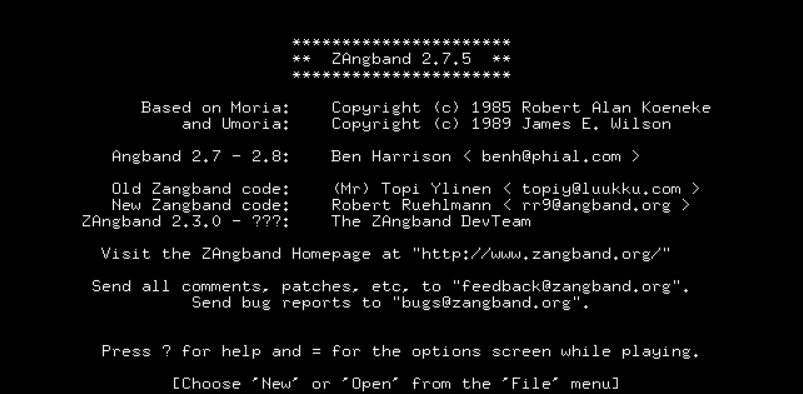
We could consider Zangband to be the first major Angband variant. It forked directly off of frogknows, but contains modifications to Angband dating after that. Its list of maintainers includes Angband maintainers Ben Harrison, and Robert Rühlmann, who took over as lead maintainer Zangband from Topi Ylinen. Of note is that he stopped being the maintainer of Angband at around the same time that Zangband entered stasis, and previous Angband fansite Thangorodrim went dark. Maybe Morgoth finally got him.
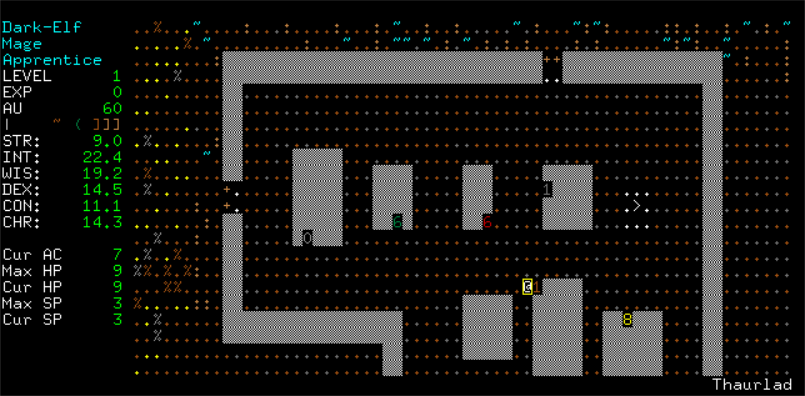
It’s a tradition to name Angband variants with some variation upon its name. The Z in Zangband stands for Roger Zelazny, the author of the Chronicles of Amber series, and contains monsters and items from that series. Cribbing from fantasy literature has long been a way that roguelike authors have paid homage to their favorite stories.
An interesting aspect of Zangband is its version of the Angband character auto-roller. Instead of going until it hits minimum stats that you specify, asks you to “weight” various stats on a scale of 1-100, and then rolls 500 characters and picks the best one rolled as judged by those weights. This means you can’t just set your character to roll dice indefinitely until you get the perfect character–or at least, you can’t do that automatically. Nothing stops you from killing the process if you don’t get a character with stats you like and trying again, as many times as you like. Statistical cheese has, after all, long been part of the flavor of rolling up character stats, dating back to all those D&D house rules groups used to make characters more powerful/interesting than typically produced by the old roll-3D6-six-times-then-assign system.
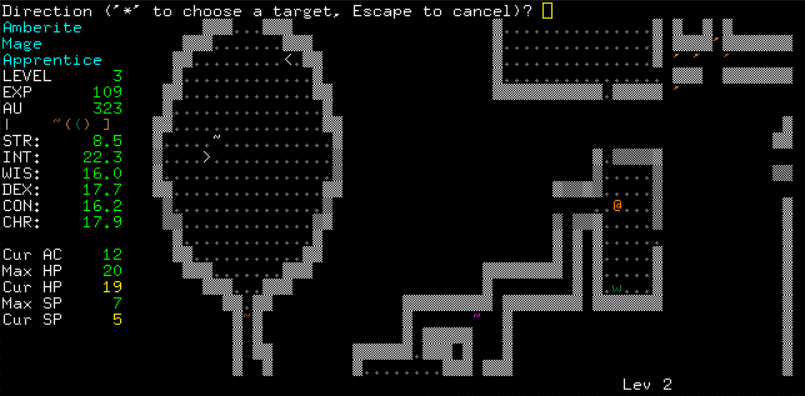
In addition to adding a lot of new character classes and monsters based on the Amber books, and other sources as well because why not, Zangband opens up the world outside the starter town. You can step past the walls of Angband’s town and see the outside world! That world works rather like a horizontal dungeon: instead of diving down into the earth, you can explore outward in all directions through the wilderness, which is filled with varied terrain kind of in the style of Minecraft. A new character can die very quickly that way, however; unexpectedly, the first levels of the main dungeon are rather easier to survive than just outside the town’s gates. If you have a means of defeating strong monsters, though, it’s possible to gain levels very rapidly without traveling too far from the starting town.
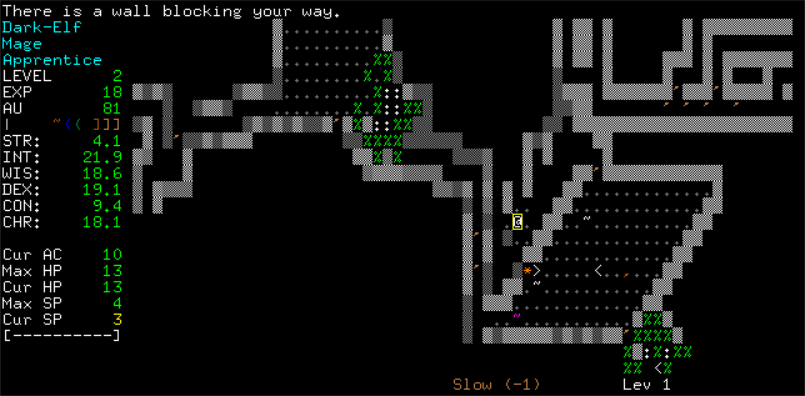
Out in the wilderness there are other towns to find, some of them with their own entrances into the dungeon (which work just as if you had entered it from the main town). As you progress out further from what we might call Point Zero, the monsters found in the wilderness get more dangerous. Some towns have special kinds of shops that are not to be found in the starting shop. The game’s bosses, which have been changed to the Amber-flavored Oberon on Level 99 and the Serpent of Chaos on level 100, are only found down in the dungeon.
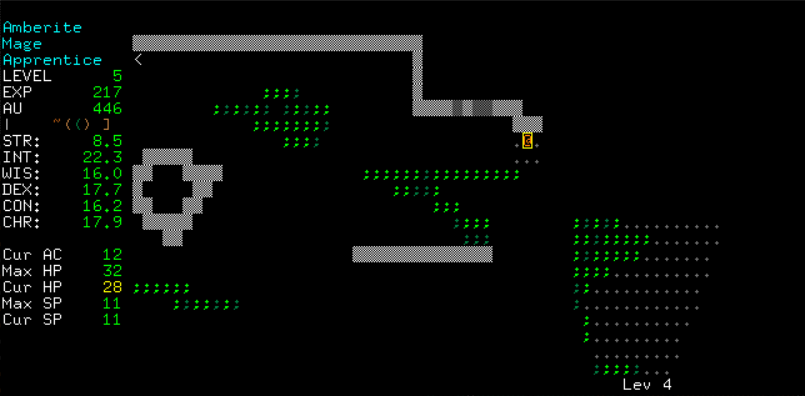
While it did pick up some of Angband’s later advancements, it still halted development nearly two decades ago. Angband has changed a fair bit in the time since Zangband became frozen, so to speak, in Amber. Playing it requires getting used to the many little things that Angband has abandoned in more recent years, like having to actively search for secret doors and traps. If you’re playing a magic-using class, it’s possible for your starting spellbooks to get incinerated by a fire attack, then for you to head back to town and find that it’s not for sale. Once you’re alert to the danger of this, you’ll know to buy extras when you can and keep them in your house. It’s the kind of affliction that affects most players exactly once, which is a common enough experience in the world of classic roguelikes.
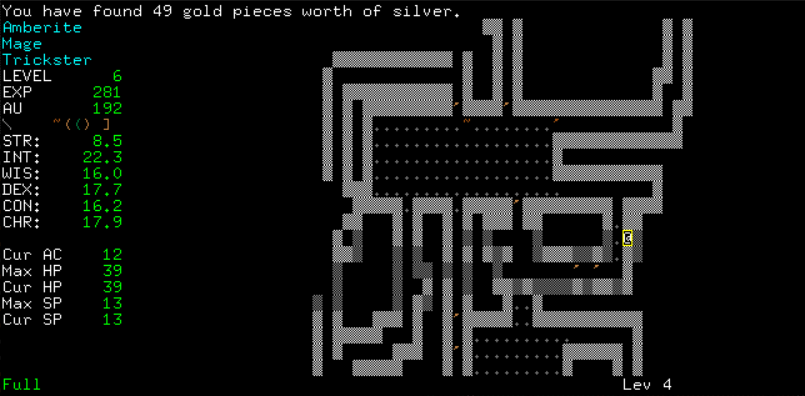
Zangband is notable for itself inspiring a bunch of variants, in fact a lot of Angband variants get those genes through Zangband as an intermediate parent. Its inclusionist philosophy of adding a whole bunch of monsters and things, and its inclusion of a persistent overworld (which it originally borrowed from Kangband) might explain the attraction.
While Zangband hasn’t been updated in nearly twenty years, its website persisted doggedly until just earlier this year, at zangband.org. Sadly, it has finally succumbed to linkrot, and now can only be found through the graces of the Internet Archive. Its Sourceforge repository still exists however, meaning you can still obtain the game through a living site, at: https://sourceforge.net/projects/zangband
